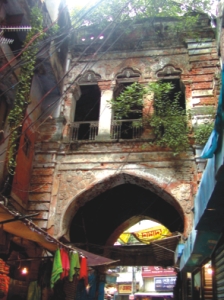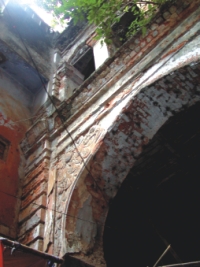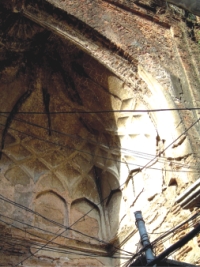Heritage Saving Puran Dhaka
Taimur Islam
THE catastrophic effect of the earthquake that struck Muzaffarabad and other parts of North Western region of South Asia came on the heels of a sustained mild tremor that shook Dhaka. This has raised quite an alarm among the members of the establishment in our country, that includes professionals, practitioners, academicians and government bodies, as well as general people. The disaster is being widely referred to as a wakeup call, urging the concerned authority to take necessary precautionary and preparatory steps.
 For quite some time, professionals, academicians and activists have been expressing their concern about the imminentness of an earthquake of catastrophic proportions hitting our country, considering the 100-year cycle for a repeat occurrence, since the great earth quake of 1897.The extent and magnitude of the damage could be cataclysmic; very little of our beloved Dhaka is expected to survive. For quite some time, professionals, academicians and activists have been expressing their concern about the imminentness of an earthquake of catastrophic proportions hitting our country, considering the 100-year cycle for a repeat occurrence, since the great earth quake of 1897.The extent and magnitude of the damage could be cataclysmic; very little of our beloved Dhaka is expected to survive.
Unfortunately, little progress has been made in terms of policy and adequate legislative support for the development controls and guidelines to avert damage from such a natural disaster. Up till now we have not been able to address the different aspects and elements of our pluralistic built environment , where the old and the new, formal and informal, permanent and makeshift all remain side by side. The extent and complexity of the situation would require an equally comprehensive approach involving multiple agencies in developing an adequate package of policy measures, guidelines and development controls along with appropriate legal support. All this requires a huge amount of time and resources.
What is of concern is that by the time the establishment wakes up, there will be very little time to go into the details of the different aspects of the problem to develop an adequate comprehensive package. In all likelihood we will end up with an array of very simplistic measures that would fail to take into account the different layers and diversity of our urban fabric and the built environment.
Against the backdrop of such developments the issue of the cultural heritage assets is pushed back to the backseats making them all the more vulnerable. A very important part of our city is physically and spiritually composed of and covered by the labyrinthine urban sprawl known as Old Dhaka or Puran Dhaka. Puran Dhaka is like a frozen history where layers of the different ages of the city over the last 500 years remains inscribed. Like any other historical city it is embedded with the memories of the glory days, the troubled times, the course of development.
 Other than archeological sites and cultural landscapes, conservation of tangible cultural heritage assets, involves monuments, their surroundings, historic areas. It is heartening to see an increase in the awareness regarding environment and natural assets; a considerable amount of efforts has made. Significant development in the case of archeological has been made in the last few years. Other than archeological sites and cultural landscapes, conservation of tangible cultural heritage assets, involves monuments, their surroundings, historic areas. It is heartening to see an increase in the awareness regarding environment and natural assets; a considerable amount of efforts has made. Significant development in the case of archeological has been made in the last few years.
The same cannot be said about monuments. Even today we are not absolutely certain about what constitutes our heritage which structures should be considered as monuments and what we are going to do about them. How are we going to protect them and their surroundings? The only list of monuments that is available has been published by the Archeological Department and this list is neither a comprehensive one nor being followed for the protection of the concerned structures.
But the situation is worst in the case of historic areas. In the absence of appropriate policy guidelines and legislative support the historic areas and sites are facing worsening situations where their protection or conservation is becoming impossible. Area conservation essentially requires the involvement of the land-owners or residents from the very beginning of the conservation process. Starting from convincing the residents about the benefits and positive effects of conservation, the financial and economic assistance to be provided, making them aware of the obligations and responsibilities for the maintenance of the buildings, all this can be a very lengthy process. Ironically, most of the members of the establishment do not have a clear perception about area conservation.
Among the residents, there is considerable skepticism about conservation of the historic areas of the city. This stems mainly from the failure to reconcile the demands of economic opportunity and the social aspirations on one hand and the cultural identity and obligations to the city, on the other. The apathy towards conservation among the policymakers, experts and academics about the potential and scope, even the viability of area conservation is making the situation even more complex. We know this would require a whole set of legislative, scientific, technical, administrative and financial measures.
Considering the degree of complexity involved in the process and the lack of political support even the most passionate activists campaigning for area conservation would find it difficult to be very optimistic. Making the situation worse, the simplistic and self destructive approach of urban renewal is gaining steam every day among the establishment which includes the practitioners, academics and professionals involved in the design and planning of the urban areas, along with the policy makers and local leaders.
 We need to remind them that cultural heritage assets are irreplaceable. Our heritage is not only what we have inherited from our ancestors but also what we owe to our future generations. Puran Dhaka has been a treasure house of heritage assets, we have already lost so much of it but still there is so much to protect, we have to act now; before all is lost. We need to remind them that cultural heritage assets are irreplaceable. Our heritage is not only what we have inherited from our ancestors but also what we owe to our future generations. Puran Dhaka has been a treasure house of heritage assets, we have already lost so much of it but still there is so much to protect, we have to act now; before all is lost.
In the absence of appropriate Heritage Protection Act or any effort from the concerned authorities to intervene and implement whatever guidelines or policies included in the Archeological Heritage Conservation Act, lack of enforcement of development control bylaws of RAJUK or other regulating agencies, the situation of Puran Dhaka is quite grave. Rampant redevelopment work is in progress in different areas of Puran Dhaka, in most cases flouting every possible clause of the present building by-laws or the law of the land.
It is our misfortune that at present, most of the old buildings due to their lime mortar masonry construction system, are considered vulnerable, thanks to a hastily completed government-run technical assessment of the structures. The Technical Committee was commissioned following the collapse of an old building in Shankhari Bazaar. Within one month a three-member technical assessment team identified about 700 buildings all over Dhaka as vulnerable. In Shankhari Bazaar alone, it has recommended the dismantling of about 70-80 buildings. Though many of those buildings individually or as groups of buildings are of historic, aesthetic, scientific, social and spiritual significance, today they are waiting for the guillotine of dismantlement, again thanks to the Technical Assessment committee recommendation.
According to a number of eminent structural designers of our country, there is no reason to conclude that those buildings require dismantling. They do require strengthening of the structure, against earthquake or other extreme lateral stress. But that cannot be the justification for dismantling; especially considering the heritage significance of the buildings. Retrofitting of structures remains an important option.
If the urgency of the situation had forced the government to complete the TA in such a hurried manner, precious little has been done since then to come up with an actual remedy of the situation. The technical assessment was followed by lofty talks about government-financed full-scale redevelopment of the mohallas that would result in high-rise buildings which would be neither viable nor a correct approach. After about 15 months since the incident, an informal sector-based redevelopment process has taken  over the scenario which is rampantly replacing the old buildings with new multi-storied buildings ranging from seven to nine stories in height. In many cases they are flouting every possible clause of the present building laws or the law of the land. Not to speak of the damage that is being done to the cultural heritage. The city is critically suffering from erosion of heritage. Our cultural heritage is gradually becoming extinct, in fact it is the most endangered component of our lives. over the scenario which is rampantly replacing the old buildings with new multi-storied buildings ranging from seven to nine stories in height. In many cases they are flouting every possible clause of the present building laws or the law of the land. Not to speak of the damage that is being done to the cultural heritage. The city is critically suffering from erosion of heritage. Our cultural heritage is gradually becoming extinct, in fact it is the most endangered component of our lives.
It is also accompanied by a spree of surface repair of the buildings which is not being subjected to redevelopment. In many instances the ornamental designs are being scraped off in an effort to hide the antiquity of the buildings. If the buildings had structural problems then there is no reason to believe that they have been made safe by superficial repairs; people are actually living under the same unsafe situation. Among experts there is no conflict of opinion that under severe lateral stress situations like an earthquake, many of these buildings may actually parish. By running a detailed technical assessment many of these buildings can easily be saved through only structural consolidation (strengthening of the structure). Indiscriminate redevelopment of historic buildings is taking place due to the high land price of old areas.
 The situation is worse in the Hindu majority/erstwhile Hindu majority areas. Condemned by the Vested Property Act many of the landowners have become squatters on the properties that are lawfully theirs through inheritance. Moreover due to the differences and conflicts, even legal fights spawned by multiple ownership and mixed tenureship, the buildings are at first pushed into a phase of gradual degradation; then in many instances they are left abandoned, and finally, they are dismantled and subjected to redevelopment usually into multi-storied apartment buildings. This is done flouting every single clause of the building bylaws. In many instances these buildings, located on narrow lanes, rise up to eight to nine stories. This widely practiced approach is patronised by a nexus of local political leaders, capital owners and informal developers. The situation is worse in the Hindu majority/erstwhile Hindu majority areas. Condemned by the Vested Property Act many of the landowners have become squatters on the properties that are lawfully theirs through inheritance. Moreover due to the differences and conflicts, even legal fights spawned by multiple ownership and mixed tenureship, the buildings are at first pushed into a phase of gradual degradation; then in many instances they are left abandoned, and finally, they are dismantled and subjected to redevelopment usually into multi-storied apartment buildings. This is done flouting every single clause of the building bylaws. In many instances these buildings, located on narrow lanes, rise up to eight to nine stories. This widely practiced approach is patronised by a nexus of local political leaders, capital owners and informal developers.
Making the situation worse, even intellectuals, experts involved in the design and planning of the urban areas, along with the policy makers and local leaders are increasingly opting for this simplistic and self-destructive approach. We need to remind them that.Puran Dhaka is a perennial source of tangible cultural heritage. We have already lost much of the unique resource of heritage, but still there is so much to protect, we have to act now.
How Can We Save Our Heritage -
A policy and guideline for area conservation should be prepared
-
A heritage commission should be formed
-
The process for the preparation of a comprehensive register of heritage buildings, group of buildings and historic areas should be initiated without any delay. After completion of the list it should be publicly declared.
-
Historic areas should be demarcated and declared.
-
A detailed Technical Assessment of old buildings should be started to ascertain the levels of vulnerability of the old buildings
-
Protective measures for Listed Buildings found vulnerable, depending on the degree of vulnerability, should be initiated
-
Protection should be provided with adequate legislative support
-
Steps for damage control and repair should be taken, at least to ensure that the designated buildings do not suffer from further damage due to lack of maintenance and repair
The writer is a member of Urban Study Group (USG) which is a voluntary organisation involved in action research. USG is campaigning for the conservation of Shakhari Bazaar, a traditional moholla of Puran Dhaka
Photo credit: Joyobroto Sharma & Russel Copyright
(R) thedailystar.net 2005 |
